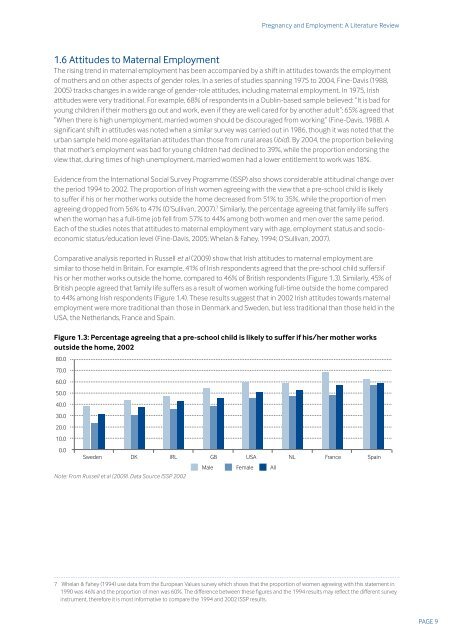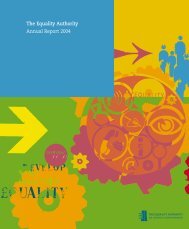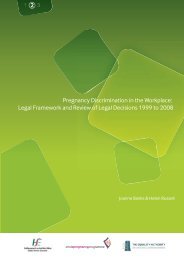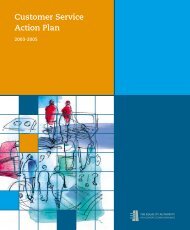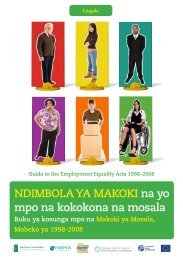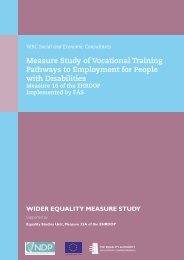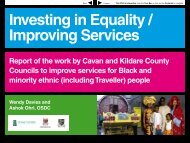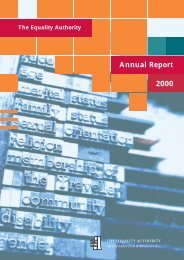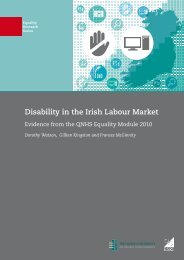Pregnancy and Employment: A Literature Review - Crisis Pregnancy ...
Pregnancy and Employment: A Literature Review - Crisis Pregnancy ...
Pregnancy and Employment: A Literature Review - Crisis Pregnancy ...
Create successful ePaper yourself
Turn your PDF publications into a flip-book with our unique Google optimized e-Paper software.
<strong>Pregnancy</strong> <strong>and</strong> <strong>Employment</strong>: A <strong>Literature</strong> <strong>Review</strong><br />
1.6 Attitudes to Maternal <strong>Employment</strong><br />
The rising trend in maternal employment has been accompanied by a shift in attitudes towards the employment<br />
of mothers <strong>and</strong> on other aspects of gender roles. In a series of studies spanning 1975 to 2004, Fine-Davis (1988,<br />
2005) tracks changes in a wide range of gender-role attitudes, including maternal employment. In 1975, Irish<br />
attitudes were very traditional. For example, 68% of respondents in a Dublin-based sample believed: “It is bad for<br />
young children if their mothers go out <strong>and</strong> work, even if they are well cared for by another adult”; 65% agreed that<br />
“When there is high unemployment, married women should be discouraged from working” (Fine-Davis, 1988). A<br />
significant shift in attitudes was noted when a similar survey was carried out in 1986, though it was noted that the<br />
urban sample held more egalitarian attitudes than those from rural areas (ibid). By 2004, the proportion believing<br />
that mother’s employment was bad for young children had declined to 39%, while the proportion endorsing the<br />
view that, during times of high unemployment, married women had a lower entitlement to work was 18%.<br />
Evidence from the International Social Survey Programme (ISSP) also shows considerable attitudinal change over<br />
the period 1994 to 2002. The proportion of Irish women agreeing with the view that a pre-school child is likely<br />
to suffer if his or her mother works outside the home decreased from 51% to 35%, while the proportion of men<br />
agreeing dropped from 56% to 47% (O’Sullivan, 2007). 7 Similarly, the percentage agreeing that family life suffers<br />
when the woman has a full-time job fell from 57% to 44% among both women <strong>and</strong> men over the same period.<br />
Each of the studies notes that attitudes to maternal employment vary with age, employment status <strong>and</strong> socioeconomic<br />
status/education level (Fine-Davis, 2005; Whelan & Fahey, 1994; O’Sullivan, 2007).<br />
Comparative analysis reported in Russell et al (2009) show that Irish attitudes to maternal employment are<br />
similar to those held in Britain. For example, 41% of Irish respondents agreed that the pre-school child suffers if<br />
his or her mother works outside the home, compared to 46% of British respondents (Figure 1.3). Similarly, 45% of<br />
British people agreed that family life suffers as a result of women working full-time outside the home compared<br />
to 44% among Irish respondents (Figure 1.4). These results suggest that in 2002 Irish attitudes towards maternal<br />
employment were more traditional than those in Denmark <strong>and</strong> Sweden, but less traditional than those held in the<br />
USA, the Netherl<strong>and</strong>s, France <strong>and</strong> Spain.<br />
Figure 1.3: Percentage agreeing that a pre-school child is likely to suffer if his/her mother works<br />
outside the home, 2002<br />
80.0<br />
70.0<br />
60.0<br />
50.0<br />
40.0<br />
30.0<br />
20.0<br />
10.0<br />
0.0<br />
Sweden DK IRL GB USA NL France Spain<br />
Male Female All<br />
Note: From Russell et al (2009). Data Source ISSP 2002<br />
7 Whelan & Fahey (1994) use data from the European Values survey which shows that the proportion of women agreeing with this statement in<br />
1990 was 46% <strong>and</strong> the proportion of men was 60%. The difference between these figures <strong>and</strong> the 1994 results may reflect the different survey<br />
instrument, therefore it is most informative to compare the 1994 <strong>and</strong> 2002 ISSP results.<br />
PAGE 9


